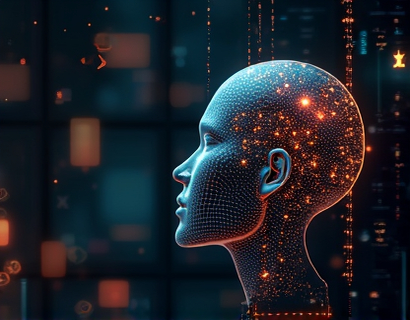Exploring the Future of Digital Communication: The Rise of AI Chat Avatars
The digital landscape is evolving at an unprecedented pace, driven by advancements in artificial intelligence and conversational technology. At the forefront of this revolution are AI chat avatars, sophisticated virtual entities designed to engage users in profound and meaningful conversations. These avatars are not just tools; they are gateways to a new era of interactive and immersive digital experiences. This article delves into the world of AI chat avatars, exploring their capabilities, applications, and the transformative impact they are having on how we communicate online.
The Evolution of Conversational AI
The journey of conversational AI began with simple chatbots, programmed to handle basic customer service inquiries and perform routine tasks. However, the leap to AI chat avatars represents a significant advancement. These avatars leverage machine learning, natural language processing, and deep learning to understand and generate human-like text and speech. The result is a more natural, intuitive, and engaging interaction experience.
The evolution of conversational AI can be traced through several key milestones. Early chatbots relied on predefined scripts and keyword matching, limiting their effectiveness. The introduction of machine learning algorithms allowed chatbots to learn from interactions, improving their responses over time. The integration of neural networks and transformer models marked a pivotal shift, enabling avatars to comprehend context, nuance, and even emotions in human language.
Key Components of AI Chat Avatars
AI chat avatars are complex systems composed of various components working in harmony. At the core is the natural language understanding (NLU) module, which interprets user input and extracts meaningful information. This module employs techniques like tokenization, part-of-speech tagging, and semantic analysis to grasp the intent and context of the conversation.
The natural language generation (NLG) module is equally crucial, responsible for crafting responses that are coherent, relevant, and engaging. Modern NLG systems use generative models such as GPT-3, which can produce human-quality text based on the input context. These models are trained on vast datasets, allowing them to generate diverse and creative responses.
Another essential component is the dialogue management system, which maintains the flow of the conversation. This system keeps track of the conversation history, manages state, and ensures that responses are contextually appropriate. Advanced dialogue managers can handle multi-turn conversations, remember previous interactions, and even adapt to the user's preferences and mood.
Applications of AI Chat Avatars
The applications of AI chat avatars are vast and varied, spanning multiple industries and use cases. In customer service, chat avatars provide 24/7 support, handling queries, resolving issues, and enhancing user satisfaction. Their ability to understand and respond to complex customer needs makes them invaluable assets for businesses.
In education, AI chat avatars serve as personalized tutors, offering tailored explanations, answering questions, and providing feedback. They can adapt to different learning styles and paces, making education more accessible and effective. For instance, a chat avatar can guide a student through a complex mathematical concept, breaking it down into manageable steps and offering real-time assistance.
The healthcare sector also benefits from AI chat avatars. These avatars can assist patients with symptom checking, provide health advice, and schedule appointments. They can offer emotional support and companionship, which is particularly valuable for patients with chronic conditions or those in isolation. A chat avatar in healthcare can streamline patient interactions, reduce the burden on medical staff, and improve overall care quality.
In the realm of entertainment, AI chat avatars enhance user experiences in games, virtual reality, and interactive stories. They can create immersive narratives, respond to player actions, and adapt the storyline based on user choices. This level of interactivity makes digital experiences more engaging and personalized.
Designing Engaging AI Chat Avatars
Creating an engaging AI chat avatar requires a thoughtful design approach that considers both technical and human factors. First, the avatar's personality and tone should align with the target audience and brand identity. A friendly and approachable tone can make interactions more pleasant and trustworthy.
Visual design is another critical aspect. While text-based avatars are common, incorporating graphical elements such as emojis, avatar images, or even 3D models can enhance the user experience. The visual representation should be consistent and reflective of the avatar's personality.
Interactivity is key to keeping users engaged. AI chat avatars should be able to handle a wide range of topics and questions, providing informative and relevant responses. Implementing features like humor, empathy, and surprise can make interactions more memorable and enjoyable. For example, a chat avatar might use light-hearted jokes to break the ice or express understanding and support in challenging situations.
Challenges and Ethical Considerations
Despite their potential, AI chat avatars face several challenges and ethical considerations. One major concern is the risk of misinformation. Avatars must be designed to provide accurate and reliable information, avoiding the spread of falsehoods. Implementing robust fact-checking mechanisms and ensuring access to up-to-date knowledge bases are essential steps.
Privacy and data security are paramount. Chat avatars often handle sensitive user information, and it is crucial to implement stringent security measures to protect this data. Transparency about data usage and compliance with regulations like GDPR are necessary to build user trust.
Another ethical issue is the potential for users to form emotional bonds with chat avatars, which can lead to dependency or unrealistic expectations. Developers should clearly communicate the nature of the avatar and avoid designing interactions that could exploit users' emotions. Ethical guidelines and regular audits can help mitigate these risks.
The Future of AI Chat Avatars
The future of AI chat avatars is promising, with ongoing research and development pushing the boundaries of what is possible. Advancements in multimodal AI, which integrates text, speech, and visual inputs, will enable more natural and versatile interactions. Avatars will become more adept at understanding and responding to non-verbal cues, such as facial expressions and gestures, further enhancing the human-like experience.
The integration of AI chat avatars into everyday devices and platforms will continue to grow. Smart homes, wearables, and mobile devices will increasingly feature chat avatars as personal assistants, health monitors, and entertainment companions. The seamless integration of these avatars into our daily lives will redefine how we interact with technology.
Moreover, the collaboration between humans and AI chat avatars will lead to new forms of creativity and innovation. Writers, artists, and developers can leverage chat avatars as collaborative tools, generating ideas, refining content, and exploring new creative frontiers. The synergy between human creativity and AI intelligence will open up exciting possibilities.
Conclusion
AI chat avatars represent a significant leap forward in digital communication, offering a blend of intelligence, interactivity, and emotional intelligence. As these technologies continue to evolve, they will play an increasingly important role in shaping our online interactions. By addressing the challenges and ethical considerations, we can harness the full potential of AI chat avatars to create more engaging, informative, and meaningful digital experiences. The future is bright, and the journey is just beginning.























